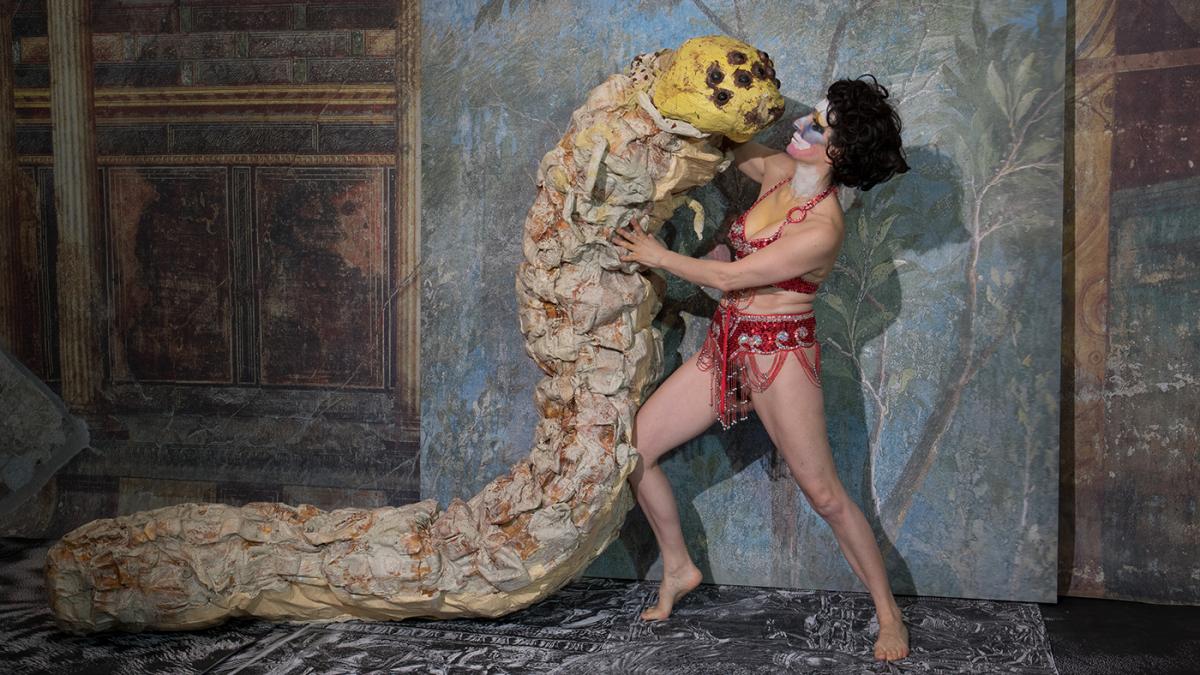Visiting Professor Monster Chetwynd educates her students through fascinating discussions
Monster Chetwynd is currently a Visiting Professor at the Academy of Fine Arts. She is known, for example, for her performances based on iconic moments in cultural history. “Monster” is her third adopted name, and each of her names has a story to tell.

Monster Chetwynd’s practice combines painting, performance art, sculpture, installation, video art and puppetry. Some of her recent works include a sculptural children’s playground inspired by Medusa’s head, which she produced at the Istanbul Biennale, and giant slugs illuminated with LED lights that were placed in front of the Tate Britain in London.
Chetwynd, who has been nominated for the Turner prize, is one of the teachers taking part in the Visiting Professor programme at Uniarts Helsinki’s Academy of Fine Arts.
According to Chetwynd, the ideas for her works arise from discussions with other people, which sometimes perplex her, and sometimes make her annoyed.
“I don’t search for information online. I prefer asking other people. This often leads to serious discussions about how we feel about certain things.”
This is not hard to believe. We have met for lunch about half an hour before the interview, and we have already discussed our childhood families, our children and how we have raised them, and what it is like to live in different countries.
In other words, we have talked about deeply personal and profound topics. Indeed, it seems to be very easy to talk with Monster Chetwynd about things that go beyond the surface.
Monster Chetwynd was born in 1973. The British artist was christened Alalia Chetwynd, and her parents’ careers took the family all around the world when she was little: Malaysia, Pakistan, Australia and Hong Kong.
“It was almost impossible to get proper school education in those circumstances. I couldn’t read or write before I was ten. I used to spend much time with my brother, which I enjoyed. It was fantastic and strange,” says Chetwynd.
Chetwynd now makes her home in Glasgow, Scotland, with her 7-year-old son.
Before studying art, Chetwynd completed a bachelor’s degree in anthropology. However, she soon realised that instead of embarking on a career of rigorous academic research, she wanted to engage in something that would allow her to express herself.
“I used to draw illustrations to all my essays, which I now feel very embarrassed about. In anthropology, the subject was very much in focus, but I was much more intrigued by objects and the material culture than people.”
Nevertheless, Chetwynd says that her background in anthropology still shows in the way in which she contextualises different things and how she places them in their historical and cultural contexts. As an artist, she is well-known, for example, for her anarchistic performances that draw on cultural-historical themes.
At the Academy of Fine Arts, Chetwynd has given puppetry and mime workshops. According to Chetwynd, these are economical and expressive art forms where you can make a big impact with little cost.
From a pedagogical perspective, however, Chetwynd emphasises the fact that the workshops raise interesting discussions.
Puppetry, for example, is a great way to reinforce the interactive connections between the members of the group. When one person is responsible for moving one arm of the puppet and another person the other one, you need to coordinate the movements together in order to make it work.
“The process makes people receptive and ties the group together. After working together as a group, people start to talk differently. They are willing to discuss more personal issues. They also become more eager to listen to what the others have to say and want to understand one another.”
“Monster” is already Chetwynd’s fourth name: her previous adopted names were Marvin Gaye and Spartacus.
Chetwynd says that changing her name was a sort of experiment. While it was very easy to do, it had remarkable consequences.
“Some people even get angry about it. Changing your name is almost like a mirror of reality, which brings out all the things that people reflect upon you.”
There is a story behind all of Chetwynd’s names. Spartacus, for example, was a reflection of solidarity.
“But then a journalist confused Spartacus with Genghis Khan. I just couldn’t use the name anymore, knowing that people could connect it with a savage conqueror instead of the leader of a slave revolt.”
Marvin Gaye was chosen because he was shot by his father and Monster wanted to remember to be aware of her relationship with her own father. Monster, on the other hand, was originally a nickname which Chetwynd’s friends used of her in jest.
“They used to tease me by saying that I was tenacious and manipulative. Then I realised that they’re in fact right, so I might as well stick with it. It’s a good, gender-neutral name. There’s a lot of room in it.”
Uniarts Helsinki’s Academy of Fine Arts invites renowned international artists and experts from different fields of art to participate in its Visiting Professor programme. The other visiting professors in 2019 are David Batchelor, Christian Benefiel, Peter McDonald, James Nisbet, Ruth Pelzer-Montada, Mira Schor and Emily Wardill.
Silja Ylitalo